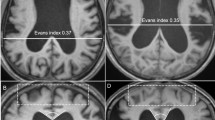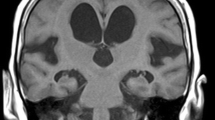Abstract
Purpose
The purpose of this study was to elucidate the specific regional cerebral blood flow (rCBF) alterations for idiopathic normal pressure hydrocephalus (iNPH) by comparing the proportional rCBF and gray matter change from those of a normal database at the same point of SPECT and MRI examinations.
Methods
Thirty subjects with iNPH underwent both CBF SPECT and MRI. After normalization, voxel-wise two-sample t tests between patients and 11 normal controls were conducted to compare the regional alteration in the gray matter density and rCBF.
Results
The rCBF reduction and the gray matter decrease were seen in almost similar regions surrounding Sylvian fissure, the left parietotemporal region and frontal lobes, whereas we did not find rCBF increase at the top of the high convexity, where the increase of the gray matter density was the highest (p < 0.05).
Conclusion
Our study showed regional associations and dissociations between the relative gray matter density and rCBF in patients with iNPH.


Similar content being viewed by others
References
Hakim S, Adams RD (1965) The special clinical problem of symptomatic hydrocephalus with normal cerebrospinal fluid pressure: observations on cerebrospinal fluid hydrodynamics. J Neurol Sci 2:307–327
Kazui H, Miyajima M, Mori E, Ishikawa M, Investigators S (2015) Lumboperitoneal shunt surgery for idiopathic normal pressure hydrocephalus (SINPHONI-2): an open-label randomised trial. Lancet Neurol 14:585–594
Hashimoto M, Ishikawa M, Mori E, Kuwana N, Study of I o n i (2010) Diagnosis of idiopathic normal pressure hydrocephalus is supported by MRI-based scheme: a prospective cohort study. Cerebrospinal Fluid Res 7:18
Iseki C, Takahashi Y, Wada M, Kawanami T, Adachi M, Kato T (2014) Incidence of idiopathic normal pressure hydrocephalus (iNPH): a 10-year follow-up study of a rural community in Japan. J Neurol Sci 339:108–112
Larsson A, Bergh AC, Bilting M, Arlig A, Jacobsson L, Stephensen H, Wikkelsö C (1994) Regional cerebral blood flow in normal pressure hydrocephalus: diagnostic and prognostic aspects. Eur J Nucl Med 21:118–123
Kristensen B, Malm J, Fagerland M, Hietala SO, Johansson B, Ekstedt J, Karlsson T (1996) Regional cerebral blood flow, white matter abnormalities, and cerebrospinal fluid hydrodynamics in patients with idiopathic adult hydrocephalus syndrome. J Neurol Neurosurg Psychiatry 60:282–288
Sasaki H, Ishii K, Kono AK, Miyamoto N, Fukuda T, Shimada K, Ohkawa S, Kawaguchi T, Mori E (2007) Cerebral perfusion pattern of idiopathic normal pressure hydrocephalus studied by SPECT and statistical brain mapping. Ann Nucl Med 21:39–45
Jagust WJ, Friedland RP, Budinger TF (1985) Positron emission tomography with [18F]fluorodeoxyglucose differentiates normal pressure hydrocephalus from Alzheimer-type dementia. J Neurol Neurosurg Psychiatry 48:1091–1096
Ohmichi T, Kondo M, Itsukage M, Koizumi H, Matsushima S, Kuriyama N, Ishii K, Mori E, Yamada K, Mizuno T, Tokuda T (2018) Usefulness of the convexity apparent hyperperfusion sign in 123I-iodoamphetamine brain perfusion SPECT for the diagnosis of idiopathic normal pressure hydrocephalus. J Neurosurg Mar 16:1–8. https://doi.org/10.3171/2017.9.JNS171100
Ishii K, Uemura T, Miyamoto N, Yoshikawa T, Yamaguchi T, Ashihara T, Ohtani Y (2011) Regional cerebral blood flow in healthy volunteers measured by the graph plot method with iodoamphetamine SPECT. Ann Nucl Med 25:255–260
Ashburner J (2007) A fast diffeomorphic image registration algorithm. Neuroimage 38:95–113
Ishii K, Kanda T, Harada A, Miyamoto N, Kawaguchi T, Shimada K, Ohkawa S, Uemura T, Yoshikawa T, Mori E (2008) Clinical impact of the callosal angle in the diagnosis of idiopathic normal pressure hydrocephalus. Eur Radiol 18:2678–2683
Ishii K, Kawaguchi T, Shimada K, Ohkawa S, Miyamoto N, Kanda T, Uemura T, Yoshikawa T, Mori E (2008) Voxel-based analysis of gray matter and CSF space in idiopathic normal pressure hydrocephalus. Dement Geriatr Cogn Disord 25:329–335
Yamashita F, Sasaki M, Saito M, Mori E, Kawaguchi A, Kudo K, Natori T, Uwano I, Ito K, Saito K (2014) Voxel-based morphometry of disproportionate cerebrospinal fluid space distribution for the differential diagnosis of idiopathic normal pressure hydrocephalus. J Neuroimaging 24:359–365
Ishii K, Hashimoto M, Hayashida K, Hashikawa K, Chang CC, Nakagawara J, Nakayama T, Mori S, Sakakibara R (2011) A multicenter brain perfusion SPECT study evaluating idiopathic normal-pressure hydrocephalus on neurological improvement. Dement Geriatr Cogn Disord 32:1–10
Ishii K, Yamaji S, Kitagaki H, Imamura T, Hirono N, Mori E (1999) Regional cerebral blood flow difference between dementia with Lewy bodies and AD. Neurology 53:413–416
Acknowledgements
This study is a sub-study of the multi-center study “SINPHONI-2.” SINPHONI-2 investigators are listed on the appendix. We thank Nihon Medi-Physics Corp for providing a graphic user interface program for constructing CBF image with the graph plot method.
Author information
Authors and Affiliations
Consortia
Corresponding author
Ethics declarations
Funding
No funding was received for this study; however, this study is a sub-study of multi-center study “SINPHONI-2” and funding was partly provided by Johnson & Johnson and Nihon Medi-Physics Corp.
Conflict of interest
KI receives lecture fees from Nihon Medi-Physics Corp.
Ethical approval
All procedures performed in the studies involving human participants were in accordance with the ethical standards of the institutional and/or national research committee and with the 1964 Helsinki Declaration and its later amendments or comparable ethical standards.
Informed consent
Informed consent was obtained from all individual participants included in the study.
Electronic supplementary material
ESM 1
(DOC 64 kb)
Rights and permissions
About this article
Cite this article
Takahashi, R., Ishii, K., Tokuda, T. et al. Regional dissociation between the cerebral blood flow and gray matter density alterations in idiopathic normal pressure hydrocephalous: results from SINPHONI-2 study. Neuroradiology 61, 37–42 (2019). https://doi.org/10.1007/s00234-018-2106-1
Received:
Accepted:
Published:
Issue Date:
DOI: https://doi.org/10.1007/s00234-018-2106-1




